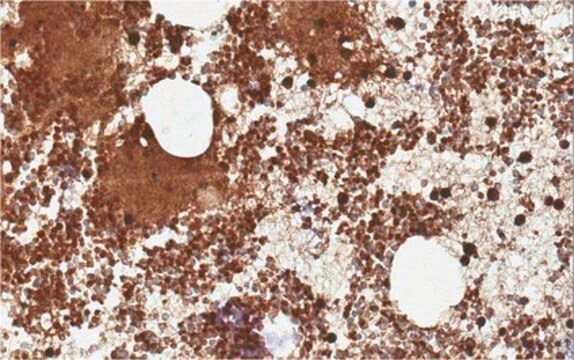MABF842
Anti-FcγRIIb/c Antibody, clone 4F5
clone 4F5, from mouse
Synonym(s):
Low affinity immunoglobulin gamma Fc region receptor II-b/c, IgG Fc receptor II-b/-c, CD32, CDw32, Fc-gamma RII-b/-c, Fc-gamma-RIIb/c, FcRII-b/-c
About This Item
Recommended Products
biological source
mouse
Quality Level
antibody form
purified immunoglobulin
antibody product type
primary antibodies
clone
4F5, monoclonal
species reactivity
human
technique(s)
flow cytometry: suitable
immunocytochemistry: suitable
immunohistochemistry: suitable (paraffin)
immunoprecipitation (IP): suitable
western blot: suitable
isotype
IgG1κ
NCBI accession no.
UniProt accession no.
shipped in
dry ice
target post-translational modification
unmodified
Gene Information
human ... FCGR2B(2213)
Related Categories
General description
Specificity
Immunogen
Application
Flow Cytometry Analysis: A representative lot was conjugated with Alexa Fluor™ 647 and detected (at 10 µg/mL) FcγRIIb/c immunoreactivity among the CD19+ B lymphocytes population in human whole blood (Courtesy of Dr. Jeffrey C. Edberg, University of Alabama at Birmingham, USA).
Flow Cytometry Analysis: A representative lot was conjugated with Alexa Fluor 488 and detected FcγRIIb/c immunoreactivity on the surface of EBV-transformed human B cells from various donors (Li, X., et al. (2013). Sci. Transl. Med. 5(216):216ra175).
Flow Cytometry Analysis: A representative lot was conjugated with Alexa Fluor 488 and employed to detect FcγRIIb expression on various human PBMC populations. Highest FcγRIIb level was found on CD19+ B lymphocytes, while lower expression was found among CD14+ monocytes/neutrophils and CD3+ T-cells were negative of FcγRIIb staining (Su, K., et al. (2007). J. Immunol. 178(5):3272-3280).
Flow Cytometry Analysis: Clone 4F5 hybridoma supernatant immunostained murine B lymphoma IIA1.6 cells expressing exogenously transfected human FcγRIIb, but not any of the two polymorphic forms of human FcγRIIa with either Arg131 or His131 (Su, K., et al. (2007). J. Immunol. 178(5):3272-3280).
Immunoprecipitation Analysis: A representative lot immunoprecipitated both FcγRIIb and FcγRIIc from EBV-transformed human B cells and primary human CD19+ cells (Li, X., et al. (2013). Sci. Transl. Med. 5(216):216ra175).
Immunoprecipitation Analysis: A representative lot immunoprecipitated exogenously expressed human FcγRIIb, but not any of two polymorphic forms of human FcγRIIa with either Arg131 or His131 from murine B lymphoma IIA1.6 transfectants expressing the respective human proteins (Su, K., et al. (2007). J. Immunol. 178(5):3272-3280).
Western Blotting Analysis: A representative lot detected exogenously expressed human FcγRIIb, but not any of two polymorphic forms of human FcγRIIa with either Arg131 or His131 in lysates from murine B lymphoma IIA1.6 transfectants (Su, K., et al. (2007). J. Immunol. 178(5):3272-3280).
Immunocytochemistry Analysis: A representative lot was conjugated with Alexa Fluor 488 and detected FcγRIIb/c immunoreactivity on the surface of EBV-transformed human B cells from various donors (Li, X., et al. (2013). Sci. Transl. Med. 5(216):216ra175).
Functional Analysis: Cross-linking by goat anti-mouse IgG (GαM) of clone 4F5 F(ab′)2-bound human FcγRIIb and endogenous surface IgG-BCR on IIA1.6 murine B lymphoma cells expressing transfected human FcγRIIb resulted in a reduced calcium response than that triggered by GαM in the absence of clone 4F5 F(ab′)2. Cross-linking of FcγRIa with clone 4F5 F(ab′)2-bound human FcγRIIb on the surface of U937 cells likewise reduced the calcium response triggered by FcγRIa cross-linking alone (Su, K., et al. (2007). J. Immunol. 178(5):3272-3280).
ELISA Analysis: Clone 4F5 hybridoma supernatant detected recombinant extracellular domain (EC) of human FcγRIIb, but not any of the two polymorphic forms of recombinant human FcγRIIa ECs with either Arg131 or His131 (Su, K., et al. (2007). J. Immunol. 178(5):3272-3280).
Inflammation & Immunology
Immunoglobulins & Immunology
Quality
Immunohistochemistry Analysis: A 1:50 dilution of this antibody detected FcγRIIb/c immunoreactivity in Islets of Langerhans in human pancreas tissue sections.
Target description
Physical form
Storage and Stability
Handling Recommendations: Upon receipt and prior to removing the cap, centrifuge the vial and gently mix the solution. Aliquot into microcentrifuge tubes and store at -20°C. Avoid repeated freeze/thaw cycles, which may damage IgG and affect product performance.
Other Notes
Legal Information
Disclaimer
Not finding the right product?
Try our Product Selector Tool.
Storage Class Code
12 - Non Combustible Liquids
WGK
WGK 2
Flash Point(F)
Not applicable
Flash Point(C)
Not applicable
Certificates of Analysis (COA)
Search for Certificates of Analysis (COA) by entering the products Lot/Batch Number. Lot and Batch Numbers can be found on a product’s label following the words ‘Lot’ or ‘Batch’.
Already Own This Product?
Find documentation for the products that you have recently purchased in the Document Library.
Our team of scientists has experience in all areas of research including Life Science, Material Science, Chemical Synthesis, Chromatography, Analytical and many others.
Contact Technical Service








